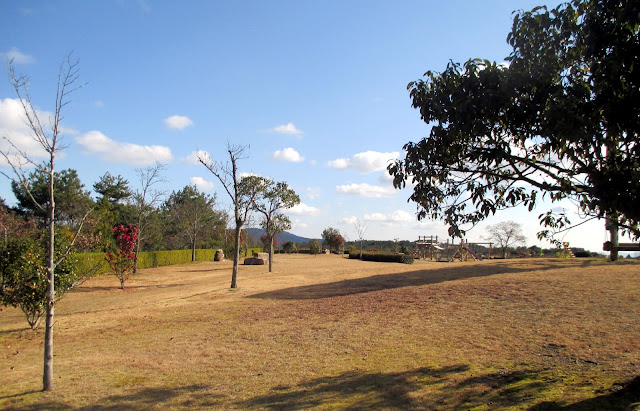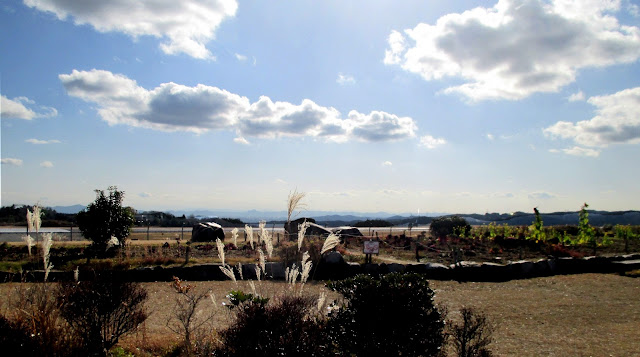Kagura
- 神楽
 |
| impression of the Japan Sea |
After
a roughly two-hour drive from Izumo Taisha along the Japan Sea coast
we arrived at our ryokan in the hot spring town of Gotsu for an
evening kagura performance at a small theater in walking
distance of the hotel. The hotel is unusually laid out. It is built
along a narrow river valley. There was a series of long hallways from
the front lobby to our room. I estimated some 200 to 300 meters in
length. Along the way there was a charming room done up in reds where
you were free to taste several different kinds of sake and wine. You
could buy a bottle if you wished, but there was no supervision and no
compulsion to buy or limit on how many “tastes” you could have.
The plum wine was excellent.
 |
one of a series of hallways
in the long hotel |
 |
| the "tasting" room |
 |
| back at ya! |
 |
| kampai! |
 |
| outdoor bath with cedar wood tub |
Our
smallish room had its own private hot spring bathroom (actually as
big as the room). Although much smaller and far less elegant than the
rocky pool we enjoyed the previous night in Matsue, the cedar-wood
tub was still a pleasant if more confined soak before going down to
the restaurant for dinner and then walking the short distance (far
less than the distance between the lobby and our room) to the kagura
performance venue.
 |
| a very small theater |
When
we arrived there were already a few people seated on a bench at the
back of the small room and on the tatami floor. I started to sit on
the mats since the bench was fully occupied but some of the men
insisted that I sit on the bench and made a place for me (in
deference, I guess, to being a foreigner who might have difficulty
sitting on the floor for a long period and consideration for my
advanced age)--kind, but not flattering. It was, I admit, more
comfortable that way, though.
 |
| performance catalog |
So
then, what is kagura?
Kagura
(神楽,
かぐら,
"god-entertainment") is a
Japanese word
referring to a specific type of
Shinto theatrical
dance—with roots arguably predating those of Noh.
They were originally ceremonial dances performed at Shinto shrines
depicting mythological themes from the oldest chronicles of Japan the
ca.
712 CE
Kojiki
and the ca.
720 CE Nihon
Shoki.
 |
| 5th Grade boy dances the Ebisu dance |
Four
different dances were performed on the tiny stage which included the
orchestra--traditional drum, flute and percussion instruments (some played by very young children), and the dance floor space. One dance was performed by a 5th
Grade boy. He portrayed the god of plenty called Ebisu,
a
somewhat rotund and jolly faced character. He ended his dance by
tossing wrapped candies, of which I caught quite a few, into the
audience.
Gorgeous Costumes and Fantastic Masks
Susano-o and the Yamata no Orochi
 |
| the Earth Deity and wife (The Old Couple) |
 |
| Susano-o pouring sake into Yamata no Orochi |
The
main dances of this evening concerned the Japanese Deity Susano-o
no Mikoto god
of the sea and storms
(brother
of the Sun Goddess
Amaterasu) and
his battle with the giant 8-headed snake-dragon Yamata
no Orochi who
was devouring young maidens, who were the daughters of an old couple
who had only one daughter left. The old man was an Earthly Deity
named Ashi-nadzuchi.
His wife's name was Te-nadzuchi.
Their surviving daughter's name was Kushi-nada-hime.The
old couple pleaded with Susano-o to save their last daughter from the
monster. Susano-o agreed if they would give him the girl to be his
wife. The snake dance is usually performed with eight snakes
(representing the 8-headed monster) if the stage is big enough. Our
stage was far too small to accommodate eight snakes and only three
were used; but in the small enclosure the final battle was quite
impressive and loooong. The battle was touch and go with sometimes
the snakes winning and then Susano-o seemed to have the advantage,
then the snakes writhing and wrapping him in their snaky bodies; the
snakes were plied with buckets of sake until one by one Susano-o
severed the snakes heads and, at last, emerged victorious.
 |
| Susano-o chopping off one of Yamata's heads |























































